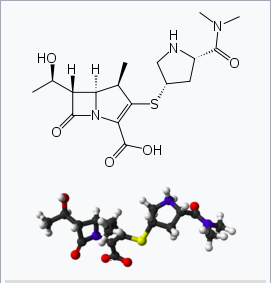Meropenem / vaborbactam (Vabomere)
Editor-In-Chief: C. Michael Gibson, M.S., M.D. [1]; Associate Editor(s)-in-Chief: Sonya Gelfand
Disclaimer
WikiDoc MAKES NO GUARANTEE OF VALIDITY. WikiDoc is not a professional health care provider, nor is it a suitable replacement for a licensed healthcare provider. WikiDoc is intended to be an educational tool, not a tool for any form of healthcare delivery. The educational content on WikiDoc drug pages is based upon the FDA package insert, National Library of Medicine content and practice guidelines / consensus statements. WikiDoc does not promote the administration of any medication or device that is not consistent with its labeling. Please read our full disclaimer here.
Overview
Meropenem / vaborbactam (Vabomere) is a combination of meropenem, a penem antibacterial, and vaborbactam, a beta-lactamase inhibitor that is FDA approved for the treatment of patients 18 years and older with complicated urinary tract infections (cUTI) including pyelonephritis caused by designated susceptible bacteria. Common adverse reactions include headache, phlebitis/infusion site reactions, and diarrhea.
Adult Indications and Dosage
FDA-Labeled Indications and Dosage (Adult)
Indications
Complicated Urinary Tract Infections (cUTI), including Pyelonephritis
- Meropenem/vaborbactam is indicated for the treatment of patients 18 years of age and older with complicated urinary tract infections (cUTI) including pyelonephritis caused by the following susceptible microorganisms: Escherichia coli, Klebsiella pneumoniae, and Enterobacter cloacae species complex.
Usage
- To reduce the development of drug-resistant bacteria and maintain the effectiveness of meropenem/vaborbactam and other antibacterial drugs, meropenem/vaborbactam should be used only to treat or prevent infections that are proven or strongly suspected to be caused by susceptible bacteria. When culture and susceptibility information are available, they should be considered in selecting or modifying antibacterial therapy. In the absence of such data, local epidemiology and susceptibility patterns may contribute to the empiric selection of therapy.
Recommended Dosage
- The recommended dosage of meropenem/vaborbactam is 4 grams (meropenem 2 grams and vaborbactam 2 grams) administered every 8 hours by intravenous (IV) infusion over 3 hours in patients 18 years of age and older with an estimated glomerular filtration rate (eGFR) greater than or equal to 50 mL/min/1.73m2. The duration of treatment is for up to 14 days.
Dosage Adjustments in Patients with Renal Impairment
- Dosage adjustment is recommended in patients with renal impairment who have an eGFR less than 50 mL/min/1.73m2. The recommended dosage of meropenem/vaborbactam in patients with varying degrees of renal function is presented in Table 1. For patients with changing renal function, monitor serum creatinine concentrations and eGFR at least daily and adjust the dosage of meropenem/vaborbactam accordingly.
- Meropenem and vaborbactam are removed by hemodialysis. For patients maintained on hemodialysis, administer meropenem/vaborbactam after a hemodialysis session.
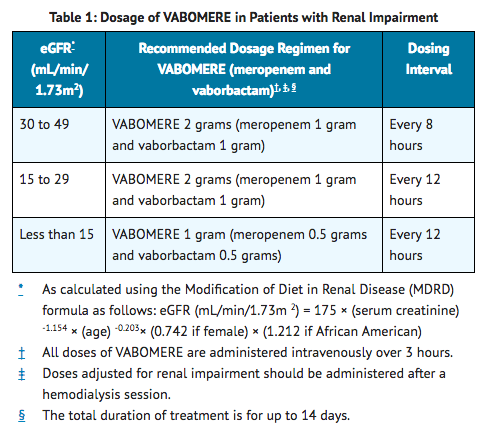
Drug Compatibility
- Meropenem/vaborbactam solution for administration by 3-hour infusion is only compatible with 0.9% Sodium Chloride Injection, USP.
- Compatibility of meropenem/vaborbactam solution for administration with other drugs has not been established.
Dosage Forms and Strengths
- Meropenem/vaborbactam 2 grams (meropenem and vaborbactam) for injection, is supplied as a white to light yellow sterile powder for constitution in single-dose, clear glass vials containing meropenem 1 gram (equivalent to 1.14 grams meropenem trihydrate) and vaborbactam 1 gram.
Off-Label Use and Dosage (Adult)
Guideline-Supported Use
There is limited information regarding meropenem/vaborbactam Off-Label Guideline-Supported Use and Dosage (Adult) in the drug label.
Non–Guideline-Supported Use
There is limited information regarding meropenem/vaborbactam Off-Label Non-Guideline-Supported Use and Dosage (Adult) in the drug label.
Pediatric Indications and Dosage
FDA-Labeled Indications and Dosage (Pediatric)
There is limited information regarding Meropenem / vaborbactam (Vabomere) FDA-Labeled Indications and Dosage (Pediatric) in the drug label.
Off-Label Use and Dosage (Pediatric)
Guideline-Supported Use
There is limited information regarding meropenem/vaborbactam Off-Label Guideline-Supported Use and Dosage (Pediatric) in the drug label.
Non–Guideline-Supported Use
There is limited information regarding meropenem/vaborbactam Off-Label Non-Guideline-Supported Use and Dosage (Pediatric) in the drug label.
Contraindications
- Meropenem/vaborbactam is contraindicated in patients with known hypersensitivity to any components of meropenem/vaborbactam, or to other drugs in the same class or in patients who have demonstrated anaphylactic reactions to beta-lactam antibacterial drugs.
Warnings
Hypersensitivity Reactions
- Hypersensitivity reactions were reported in patients treated with meropenem/vaborbactam in the clinical trials. Serious and occasionally fatal hypersensitivity (anaphylactic) reactions and serious skin reactions have been reported in patients receiving therapy with beta-lactam antibacterial drugs. These reactions are more likely to occur in individuals with a history of sensitivity to multiple allergens. There have been reports of individuals with a history of penicillin hypersensitivity who have experienced severe hypersensitivity reactions when treated with another beta-lactam antibacterial drug. Before initiating therapy with meropenem/vaborbactam, it is important to inquire about previous hypersensitivity reactions to penicillins, cephalosporins, other beta-lactam antibacterial drugs, and other allergens. If an allergic reaction to meropenem/vaborbactam occurs, discontinue the drug immediately.
Seizure Potential
- Seizures and other adverse Central Nervous System (CNS) experiences have been reported during treatment with meropenem, which is a component of meropenem/vaborbactam. These experiences have occurred most commonly in patients with CNS disorders (e.g., brain lesions or history of seizures) or with bacterial meningitis and/or compromised renal function.
- Close adherence to the recommended dosage regimens is urged, especially in patients with known factors that predispose to convulsive activity. Continue anti-convulsant therapy in patients with known seizure disorders. If focal tremors, myoclonus, or seizures occur, evaluate neurologically, place on anti-convulsant therapy if not already instituted, and reexamine the dosage of meropenem/vaborbactam to determine whether it should be decreased or discontinued.
Clostridium difficile-associated Diarrhea
- Clostridium difficile-associated diarrhea (CDAD) has been reported with use of nearly all antibacterial agents, including meropenem/vaborbactam, and may range in severity from mild diarrhea to fatal colitis. Treatment with antibacterial agents alters the normal flora of the colon leading to overgrowth of C. difficile.
- C. difficile produces toxins A and B which contribute to the development of CDAD. Hypertoxin-producing isolates of C. difficile cause increased morbidity and mortality, as these infections can be refractory to antimicrobial therapy and may require colectomy. CDAD must be considered in all patients who present with diarrhea following antibacterial drug use. Careful medical history is necessary since CDAD has been reported to occur over two months after the administration of antibacterial agents.
- If CDAD is suspected or confirmed, ongoing antibacterial drug use not directed against C. difficile may need to be discontinued. Appropriate fluid and electrolyte management, protein supplementation, antibacterial drug treatment of C. difficile, and surgical evaluation should be instituted as clinically indicated.
Risk of Breakthrough Seizures Due to Drug Interaction with Valproic Acid
- The concomitant use of meropenem/vaborbactam and valproic acid or divalproex sodium is generally not recommended. Case reports in the literature have shown that co-administration of carbapenems, including meropenem, to patients receiving valproic acid or divalproex sodium results in a reduction in valproic acid concentrations. The valproic acid concentrations may drop below the therapeutic range as a result of this interaction, therefore increasing the risk of breakthrough seizures. Increasing the dose of valproic acid or divalproex sodium may not be sufficient to overcome this interaction. Consider administration of antibacterial drugs other than carbapenems to treat infections in patients whose seizures are well controlled on valproic acid or divalproex sodium. If administration of meropenem/vaborbactam is necessary, consider supplemental anticonvulsant therapy.
Thrombocytopenia
- In patients with renal impairment, thrombocytopenia has been observed in patients treated with meropenem, but no clinical bleeding has been reported.
Potential for Neuromotor Impairment
- Alert patients receiving meropenem/vaborbactam on an outpatient basis regarding adverse reactions such as seizures, delirium, headaches and/or paresthesias that could interfere with mental alertness and/or cause motor impairment. Until it is reasonably well established that meropenem/vaborbactam is well tolerated, advise patients not to operate machinery or motorized vehicles.
Development of Drug-Resistant Bacteria
- Prescribing meropenem/vaborbactam in the absence of a proven or strongly suspected bacterial infection is unlikely to provide benefit to the patient and increases the risk of drug-resistant bacteria.
Overgrowth of Nonsusceptible Organisms
- As with other antibacterial drugs, prolonged use of meropenem/vaborbactam may result in overgrowth of nonsusceptible organisms. Repeated evaluation of the patient is essential. If superinfection does occur during therapy, appropriate measures should be taken.
Adverse Reactions
Clinical Trials Experience
- Because clinical trials are conducted under widely varying conditions, adverse reaction rates observed in the clinical trials of a drug cannot be directly compared to rates in the clinical trials of another drug and may not reflect the rates observed in practice.
- Meropenem/vaborbactam was evaluated in a Phase 3 comparator-controlled clinical trial in cUTI, including pyelonephritis, which included 272 patients treated with meropenem/vaborbactam and 273 patients treated with the comparator piperacillin/tazobactam 4.5 grams (piperacillin 4 g/tazobactam 0.5 g) every 8 hours. After a minimum of 15 doses of IV therapy, patients could be switched to oral levofloxacin (500 mg daily every 24 hours) to complete the treatment course. Mean duration of IV therapy was 8 days in both treatment groups. Mean duration of IV and oral therapy was 10 days; patients with baseline bacteremia could receive up to 14 days of treatment.
- The mean age of patients treated with meropenem/vaborbactam was 53 years (range 18 to 92 years), and 32% of patients were 65 years of age or older. Patients were predominantly female (66.5%) and White (93.4%). Most patients were enrolled in Europe (89.7%).
Serious Adverse Reactions and Adverse Reactions Leading to Discontinuation
- Treatment was discontinued due to adverse reactions in 2.9% (8/272) of patients receiving meropenem/vaborbactam and in 5.1% (14/273) of patients receiving piperacillin/tazobactam. Most common adverse reactions resulting in discontinuation of meropenem/vaborbactam included hypersensitivity, 1.1% (3/272) and infusion-related reactions, 0.7% (2/272). Death occurred in 2 (0.7%) patients who received meropenem/vaborbactam and in 2 (0.7%) patients who received piperacillin/tazobactam.
Common Adverse Reactions
- The most frequently reported adverse reactions (3% or greater) in patients receiving meropenem/vaborbactam in the Phase 3 cUTI trial were headache, phlebitis/infusion site reactions, and diarrhea. Table 3 provides adverse reactions occurring in 1% or greater of patients receiving meropenem/vaborbactam in the Phase 3 cUTI trial.
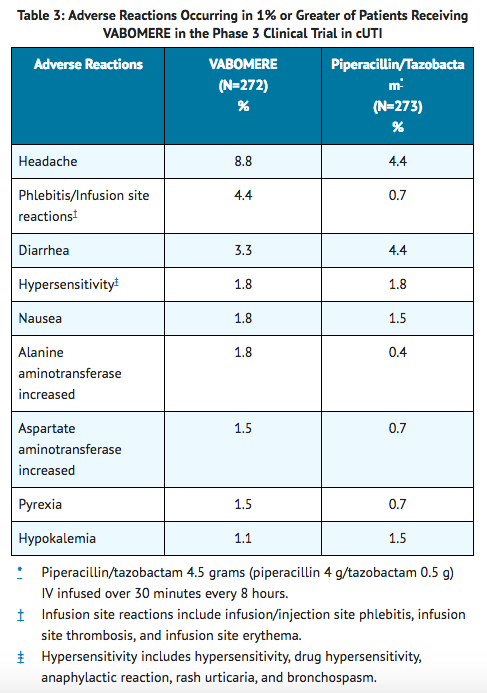
Adverse Reactions Occurring in Less Than 1% of Patients Receiving meropenem/vaborbactam in the Phase 3 cUTI trial:
- Blood and lymphatic system disorders: leukopenia
- General disorders and administration site conditions: chest discomfort
- Infections and infestations: pharyngitis, vulvovaginal candidiasis, oral candidiasis
- Investigations: creatinine phosphokinase increase
- Metabolism and nutrition disorders: decreased appetite, hyperkalemia, hyperglycemia, hypoglycemia
- Nervous system disorders: dizziness, tremor, paresthesia, lethargy
- Psychiatric disorders: hallucination, insomnia
- Renal and urinary disorders: azotemia, renal impairment
- Vascular disorders: deep vein thrombosis, hypotension, vascular pain
Other Adverse Reactions Associated with Meropenem
- Additionally, adverse reactions reported with meropenem alone that were not reported in meropenem/vaborbactam-treated patients in the Phase 3 clinical trial are listed below:
- Blood and lymphatic system disorders: thrombocytosis, neutropenia, eosinophilia, thrombocytopenia, agranulocytosis, hemolytic anemia
- Gastrointestinal disorders: abdominal pain
- Hepatobiliary disorders: jaundice
- Nervous system disorders: convulsions
- Investigations: blood alkaline phosphatase increased, blood lactate dehydrogenase increased, blood bilirubin increased, blood creatinine increased, blood urea increased, blood thromboplastin decreased, prothrombin time decreased, Direct and Indirect Coombs test positive
- Skin and subcutaneous tissue disorders: pruritus, toxic epidermal necrolysis, Stevens Johnson syndrome, Drug Reaction with Eosinophilia and Systemic Symptoms (DRESS) syndrome, erythema multiforme
- Immune system disorders: angioedema
- General disorders and administration site conditions: pain
Postmarketing Experience
There is limited information regarding Meropenem / vaborbactam (Vabomere) Postmarketing Experience in the drug label.
Drug Interactions
- Valproic Acid
- Probenecid
Valproic Acid
- Case reports in the literature have shown that co-administration of carbapenems, including meropenem, to patients receiving valproic acid or divalproex sodium results in a reduction in valproic acid concentrations. The valproic acid concentrations may drop below the therapeutic range as a result of this interaction, therefore increasing the risk of breakthrough seizures. Although the mechanism of this interaction is unknown, data from in vitro and animal studies suggest that carbapenems may inhibit the hydrolysis of valproic acid's glucuronide metabolite (VPA-g) back to valproic acid, thus decreasing the serum concentrations of valproic acid. If administration of meropenem/vaborbactam is necessary, then supplemental anti-convulsant therapy should be considered.
Probenecid
- Probenecid competes with meropenem for active tubular secretion, resulting in increased plasma concentrations of meropenem. Co-administration of probenecid with meropenem/vaborbactam is not recommended.
Use in Specific Populations
Pregnancy
Risk Summary
- Fetal malformations were observed in vaborbactam-treated rabbits, therefore advise pregnant women of the potential risks to the fetus. There are insufficient human data to establish whether there is a drug-associated risk of major birth defects or miscarriages with meropenem/vaborbactam, meropenem, or vaborbactam in pregnant women.
- Malformations (supernumerary lung lobes, interventricular septal defect) were observed in offspring from pregnant rabbits administered intravenous vaborbactam during the period of organogenesis at doses approximately equivalent to or above the maximum recommended human dose (MRHD) based on plasma AUC comparison. The clinical relevance of the malformations is uncertain. No similar malformations or fetal toxicity were observed in offspring from pregnant rats administered intravenous vaborbactam during organogenesis or from late pregnancy and through lactation at a dose equivalent to approximately 1.6 times the MRHD based on body surface area comparison.
- No fetal toxicity or malformations were observed in pregnant rats and cynomolgus monkeys administered intravenous meropenem during organogenesis at doses up to 1.6 and 1.2 times the MRHD based on body surface area comparison, respectively. In rats administered intravenous meropenem in late pregnancy and during the lactation period, there were no adverse effects on offspring at doses equivalent to approximately 1.6 times the MRHD based on body surface area comparison.
- The background risk of major birth defects and miscarriage for the indicated population is unknown. In the U.S. general population, the estimated background risk of major birth defects and miscarriage in clinically recognized pregnancies is 2-4% and 15-20%, respectively.
Data (Animal)
Meropenem
- Reproductive studies have been performed with meropenem in rats at doses of up to 1000 mg/kg/day and in cynomolgus monkeys at doses of up to 360 mg/kg/day (on the basis of body surface area comparisons, approximately 1.6 times and 1.2 times higher, respectively, than the MRHD of 2 grams every 8 hours). These studies revealed no evidence of harm to the fetus due to meropenem, although there were slight changes in fetal body weight at doses of 250 mg/kg/day (equivalent to approximately 0.4 times the MRHD of 2 grams every 8 hours based on body surface area comparison) and above in rats. In a published study1, meropenem administered to pregnant rats from Gestation Day 6 to Gestation Day 17, was associated with mild maternal weight loss at all doses, but did not produce malformations or fetal toxicity. The no-observed-adverse-effect-level (NOAEL) for fetal toxicity in this study was considered to be the high dose of 750 mg/kg/day (equivalent to approximately 1.2 times the MRHD based on body surface area comparison).
- In a peri-postnatal study in rats described in the published literature1, intravenous meropenem was administered to dams from Gestation Day 17 until Postpartum Day 21. There were no adverse effects in the dams and no adverse effects in the first generation offspring (including developmental, behavioral, and functional assessments and reproductive parameters) except that female offspring exhibited lowered body weights which continued during gestation and nursing of the second generation offspring. Second generation offspring showed no meropenem-related effects. The NOAEL value was considered to be 1000 mg/kg/day (approximately 1.6 times the MRHD based on body surface area comparisons).
Vaborbactam
- In a rat embryo-fetal toxicology study, intravenous administration of vaborbactam during Gestation Days 6-17 showed no evidence of maternal or embryofetal toxicity at doses up to 1000 mg/kg, which is equivalent to approximately 1.6 times the MRHD based on body surface area comparisons. In the rabbit, intravenous administration of vaborbactam during Gestation Days 7–19 at doses up to 1000 mg/kg/day (approximately 5 times the MRHD based on AUC exposure comparison) was not associated with maternal toxicity or fetal weight loss. A low incidence of malformations occurred in the 300 mg/kg/day mid-dose group (two fetuses from different litters with interventricular septal defects, one fetus with a fused right lung lobe and one fetus with a supernumerary lung lobe), and in the 1000 mg/kg/day high-dose group (two fetuses from different litters with supernumerary lobes). The NOAEL was considered to be 100 mg/kg/day which is equivalent to 0.3 times the MRHD based on plasma AUC exposure comparison and 6-times the MRHD based on maximum plasma concentration (Cmax) comparison. The clinical relevance of the malformations is uncertain. Vaborbactam Cmax values may have influenced malformations in the rabbit study, and the recommended 3-hour infusion time for clinical administration of vaborbactam is associated with lower plasma Cmax values than the 30-minute infusions in rabbits.
- In a peri-postnatal study in rats, vaborbactam administered intravenously to pregnant dams from Gestation Day 6 to Lactation Day 20 caused no adverse effects on the dams, or in first and second generation offspring. The NOAEL was considered to be 1000 mg/kg/day (equivalent to approximately 1.6 times the MRHD based on body surface area comparison).
Pregnancy Category (AUS):
There is no Australian Drug Evaluation Committee (ADEC) guidance on usage of Meropenem / vaborbactam (Vabomere) in women who are pregnant.
Labor and Delivery
There is no FDA guidance on use of Meropenem / vaborbactam (Vabomere) during labor and delivery.
Nursing Mothers
- Meropenem has been reported to be excreted in human milk. It is unknown whether vaborbactam is excreted in human milk. No information is available on the effects of meropenem and vaborbactam on the breast-fed child or on milk production.
- The developmental and health benefits of breastfeeding should be considered along with the mother's clinical need for meropenem/vaborbactam and any potential adverse effects on the breast-fed child from meropenem/vaborbactam or from the underlying maternal condition.
Pediatric Use
- The safety and effectiveness of meropenem/vaborbactam in pediatric patients (younger than 18 years of age) has not been established. Studies of meropenem/vaborbactam have not been conducted in patients younger than 18 years of age.
Geriatic Use
- Of the 272 patients treated with meropenem/vaborbactam in the Phase 3 cUTI trial, 48 (18%) patients were 65 years of age and older, while 39 (14%) patients were 75 years of age and older. No overall differences in safety or effectiveness were observed between these patients and younger patients, and other reported clinical experience has not identified differences in responses between the elderly and younger patients, but greater sensitivity of some older individuals cannot be ruled out.
- Meropenem, a component of meropenem/vaborbactam, is known to be substantially excreted by the kidney, and the risk of adverse reactions to this drug may be greater in patients with renal impairment. Because elderly patients are more likely to have decreased renal function, care should be taken in dose selection, and it may be useful to monitor renal function.
- Population pharmacokinetic (PK) analysis found no clinically relevant change in pharmacokinetic parameters in elderly patients. No dosage adjustment based on age is required. Dosage adjustment for elderly patients should be based on renal function.
Gender
There is no FDA guidance on the use of Meropenem / vaborbactam (Vabomere) with respect to specific gender populations.
Race
There is no FDA guidance on the use of Meropenem / vaborbactam (Vabomere) with respect to specific racial populations.
Renal Impairment
- Pharmacokinetic studies conducted with meropenem and vaborbactam in subjects with renal impairment have shown that the plasma exposures of both meropenem and vaborbactam increased with decreasing renal function. Dosage adjustment for meropenem/vaborbactam is recommended in patients with renal impairment (eGFR less than 50 mL/min/1.73m2).
- For patients with changing renal function, monitor serum creatinine concentrations and eGFR at least daily and adjust the dosage of meropenem/vaborbactam accordingly. Meropenem and vaborbactam are removed by hemodialysis. Following a single dose of meropenem/vaborbactam, vaborbactam exposure was substantially greater when meropenem/vaborbactam was administered after hemodialysis than before hemodialysis.
Hepatic Impairment
There is no FDA guidance on the use of Meropenem / vaborbactam (Vabomere) in patients with hepatic impairment.
Females of Reproductive Potential and Males
There is no FDA guidance on the use of Meropenem / vaborbactam (Vabomere) in women of reproductive potentials and males.
Immunocompromised Patients
There is no FDA guidance one the use of Meropenem / vaborbactam (Vabomere) in patients who are immunocompromised.
Administration and Monitoring
Administration
Preparation and Administration of Meropenem/vaborbactam for Intravenous Infusion
Preparation
- Meropenem/vaborbactam is supplied as a dry powder in a single-dose vial that must be constituted and further diluted prior to intravenous infusion as outlined below. Meropenem/vaborbactam does not contain preservatives. Aseptic technique must be used for constitution and dilution.
- To prepare the required dose for intravenous infusion, constitute the appropriate number of vials, as determined from Table 2 below. Withdraw 20 mL of 0.9% Sodium Chloride Injection, USP, from an infusion bag and constitute each vial of meropenem/vaborbactam.
- Mix gently to dissolve. The constituted meropenem/vaborbactam solution will have an approximate meropenem concentration of 0.05 gram/mL and an approximate vaborbactam concentration of 0.05 gram/mL. The final volume is approximately 21.3 mL. The constituted solution is not for direct injection.
- The constituted solution must be diluted further, immediately, in a 0.9% Sodium Chloride Injection, USP infusion bag before intravenous infusion. The intravenous infusion of the diluted solution must be completed within 4 hours if stored at room temperature or 22 hours if stored refrigerated at 2°C to 8°C (36°F to 46°F).
- To dilute the constituted solution, withdraw the full or partial constituted vial contents from each vial and add it back into the infusion bag in accordance with Table 2 below.
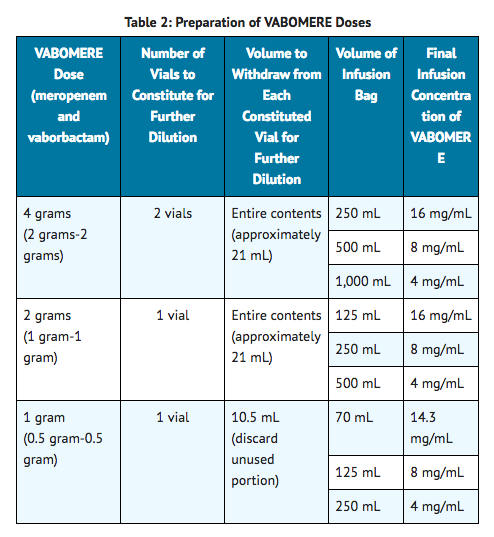
- Visually inspect the diluted meropenem/vaborbactam solution for particulate matter and discoloration prior to administration (the color of the meropenem/vaborbactam infusion solution for administration ranges from colorless to light yellow). Discard unused portion after use.
Monitoring
- Consider culture and susceptibility information before treatment initiation and with therapy modifications whenever possible.
- Improvement of complicated urinary tract infections indicates efficacy.
- Serum creatinine and estimated glomerular filtration rate: Daily in patients with changing renal function.
- Renal function: In elderly patients.
IV Compatibility
There is limited information regarding the compatibility of Meropenem / vaborbactam (Vabomere) and IV administrations.
Overdosage
- In the event of overdose, discontinue meropenem/vaborbactam and institute general supportive treatment.
- Meropenem and vaborbactam can be removed by hemodialysis. In subjects with end-stage renal disease (ESRD) administered meropenem 1 gram and vaborbactam 1 gram, the mean total recovery in dialysate following a hemodialysis session was 38% and 53% of the administered dose of meropenem and vaborbactam, respectively.
- No clinical information is available on the use of hemodialysis to treat meropenem/vaborbactam overdosage.
Pharmacology
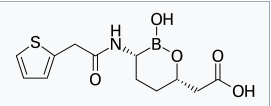
| |
Vaborbactam
| |
| Systematic (IUPAC) name | |
| {(3R,6S)-2-Hydroxy-3-[2-(thiophen-2-yl)acetamido]- 1,2-oxaborinan-6-yl}acetic acid | |
| Identifiers | |
| CAS number | |
| ATC code | None |
| PubChem | |
| Chemical data | |
| Formula | Template:OrganicBox atomTemplate:OrganicBox atomTemplate:OrganicBoxTemplate:OrganicBoxTemplate:OrganicBox atomTemplate:OrganicBoxTemplate:OrganicBoxTemplate:OrganicBoxTemplate:OrganicBoxTemplate:OrganicBoxTemplate:OrganicBoxTemplate:OrganicBoxTemplate:OrganicBoxTemplate:OrganicBox atomTemplate:OrganicBoxTemplate:OrganicBox atomTemplate:OrganicBoxTemplate:OrganicBoxTemplate:OrganicBox atomTemplate:OrganicBoxTemplate:OrganicBoxTemplate:OrganicBoxTemplate:OrganicBox |
| Mol. mass | ? |
| Pharmacokinetic data | |
| Bioavailability | ? |
| Metabolism | ? |
| Half life | ? |
| Excretion | ? |
| Therapeutic considerations | |
| Pregnancy cat. |
? |
| Legal status | |
| Routes | IV |
Mechanism of Action
- Meropenem/vaborbactam is an antibacterial drug.
Structure
- Structure of Meropenem Trihydrate
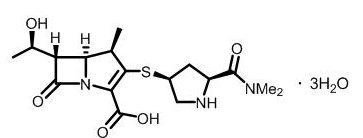
- Structure of Vaborbactam

Pharmacodynamics
- Similar to other beta-lactam antibacterial drugs, the percentage of time of a dosing interval that unbound plasma concentration of meropenem exceeds the meropenem-vaborbactam minimum inhibitory concentration (MIC) against the infecting organism has been shown to best correlate with efficacy in animal and in vitro models of infection. The ratio of the 24-hour unbound plasma vaborbactam AUC to meropenem-vaborbactam MIC is the index that best predicts efficacy of vaborbactam in combination with meropenem in animal and in vitro models of infection.
Pharmacokinetics
Pharmacokinetic (PK) Parameters
- The mean PK parameters of meropenem and vaborbactam in healthy adults with normal renal function after single and multiple 3-hour infusions of meropenem/vaborbactam 4 grams (meropenem 2 grams and vaborbactam 2 grams) administered every 8 hours are summarized in Table 4.
- The PK parameters of meropenem and vaborbactam were similar for single and multiple dose administration of meropenem/vaborbactam.
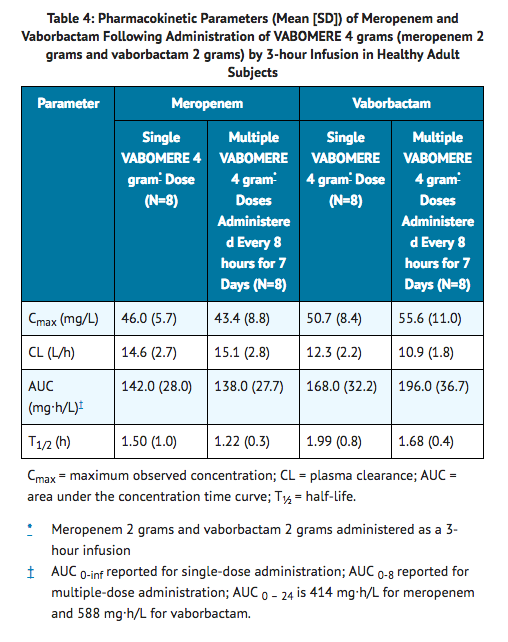
- The maximum plasma concentration (Cmax) and area under the plasma drug concentration time curve (AUC) of meropenem and vaborbactam proportionally increased with dose across the dose range studied (1 gram to 2 grams for meropenem and 0.25 grams to 2 grams for vaborbactam) when administered as a single 3-hour intravenous infusion. There is no accumulation of meropenem or vaborbactam following multiple intravenous infusions administered every 8 hours for 7 days in subjects with normal renal function.
- The mean population PK parameters of meropenem and vaborbactam in 295 patients (including 35 patients with reduced renal function) after 3-hour infusions of meropenem/vaborbactam 4 grams (meropenem 2 grams and vaborbactam 2 grams) administered every 8 hours (or dose adjusted based on renal function) are summarized in Table 5.
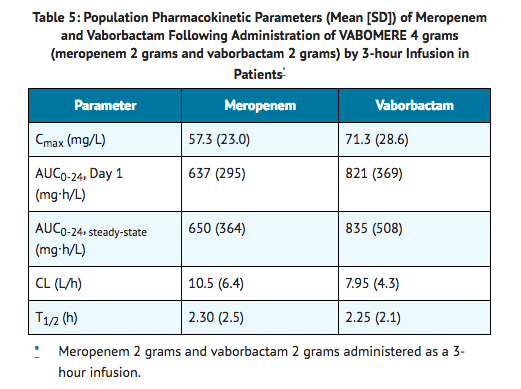
Distribution
- The plasma protein binding of meropenem is approximately 2%. The plasma protein binding of vaborbactam is approximately 33%.
- The steady-state volumes of distribution of meropenem and vaborbactam in patients were 20.2 L and 18.6 L, respectively.
Elimination
- The clearance of meropenem in healthy subjects following multiple doses is 15.1 L/h and for vaborbactam is 10.9 L/h. The t1/2 is 1.22 hours and 1.68 hours for meropenem and vaborbactam, respectively.
Metabolism
- A minor pathway of meropenem elimination is hydrolysis of the beta-lactam ring (meropenem open lactam), which accounts for 22% of a dose eliminated via the urine.
- Vaborbactam does not undergo metabolism.
Excretion
- Both meropenem and vaborbactam are primarily excreted via the kidneys.
- Approximately 40–60% of a meropenem dose is excreted unchanged within 24-48 hours with a further 22% recovered as the microbiologically inactive hydrolysis product. The mean renal clearance for meropenem was 7.8 L/h. The mean non-renal clearance for meropenem was 7.3 L/h which comprises both fecal elimination (~2% of dose) and degradation due to hydrolysis.
- For vaborbactam, 75 to 95% of the dose was excreted unchanged in the urine over a 24 to 48 hour period. The mean renal clearance for vaborbactam was 8.9 L/h. The mean non-renal clearance for vaborbactam was 2.0 L/h indicating nearly complete elimination of vaborbactam by the renal route.
Specific Populations
Patients with Renal Impairment
- Following a single dose of meropenem/vaborbactam, pharmacokinetic studies with meropenem and vaborbactam in subjects with renal impairment have shown that meropenem AUC0-inf ratios to subjects with normal renal function are 1.28, 2.07, and 4.63 for subjects with mild (eGFR of 60 to 89 mL/min/1.73m2), moderate (eGFR of 30 to 59 mL/min/1.73m2), and severe (eGFR <30 mL/min/1.73m2) renal impairment, respectively; vaborbactam AUC0-inf ratios to subjects with normal renal function are 1.18, 2.31, and 7.8 for subjects with mild, moderate, and severe renal impairment, respectively. Hemodialysis removed 38% of the meropenem dose and 53% of the vaborbactam dose. Vaborbactam exposure was high in subjects with ESRD (eGFR <15 ml/min/1.73 m2). Vaborbactam exposure was higher when meropenem/vaborbactam was administered after hemodialysis (AUC0-inf ratio to subjects with normal renal function of 37.5) than when meropenem/vaborbactam was administered before hemodialysis (AUC0-inf ratio to subjects with normal renal function of 10.2).
Patients with Hepatic Impairment
- A pharmacokinetic study conducted with an intravenous formulation of meropenem in patients with hepatic impairment has shown no effects of liver disease on the pharmacokinetics of meropenem.
- Vaborbactam does not undergo hepatic metabolism. Therefore, the systemic clearance of meropenem and vaborbactam is not expected to be affected by hepatic impairment.
Geriatric Patients
- In elderly patients with renal impairment, plasma clearances of meropenem and vaborbactam were reduced, correlating with age-associated reduction in renal function.
Male and Female Patients
- Meropenem and vaborbactam Cmax and AUC were similar between males and females using a population pharmacokinetic analysis.
Racial or Ethnic Groups
- No significant difference in mean meropenem or vaborbactam clearance was observed across race groups using a population pharmacokinetic analysis.
Drug Interactions
- No drug-drug interaction was observed between meropenem and vaborbactam in clinical studies with healthy subjects.
- Based upon the in vitro and in vivo data available to date, there is a low potential for clinically significant drug interactions with vaborbactam.
- Vaborbactam at clinically relevant concentrations does not inhibit the cytochrome P450 isoforms CYP1A2, CYP2B6, CYP2C8, CYP2C9, CYP2C19, CYP2D6, and CYP3A4 in vitro human liver microsomes. Vaborbactam showed no potential for in vitro induction of CYP1A2, CYP2B6, and CYP3A4 in human hepatocytes. Studies evaluating the potential for meropenem to interact with CYP450 enzymes or active transport systems have not been conducted. However, carbapenems as a class have not shown the potential for inhibition or induction CYP450 enzymes and clinical experience suggests that such effects are unlikely.
- Vaborbactam does not inhibit the following hepatic and renal transporters in vitro at clinically relevant concentrations: P-gp, BCRP, OAT1, OAT3, OCT1, OCT2, OATP1B1, OATP1B3 or BSEP. Vaborbactam was not a substrate of OAT1, OAT3, OCT2, P-gp, and BCRP.
- Meropenem is a substrate of OAT1 and OAT3 and as such, probenecid competes with meropenem for active tubular secretion and thus inhibits the renal excretion of meropenem. Following administration of probenecid with meropenem, the mean systemic exposure increased 56% and the mean elimination half-life increased 38%.
- Concomitant administration of meropenem and valproic acid has been associated with reductions in valproic acid concentrations with subsequent loss in seizure control.
Microbiology
Mechanism of Action
- The meropenem component of meropenem/vaborbactam is a penem antibacterial drug. The bactericidal action of meropenem results from the inhibition of cell wall synthesis. Meropenem penetrates the cell wall of most gram-positive and gram-negative bacteria to bind penicillin-binding protein (PBP) targets. Meropenem is stable to hydrolysis by most beta-lactamases, including penicillinases and cephalosporinases produced by gram-negative and gram-positive bacteria, with the exception of carbapenem hydrolyzing beta-lactamases.
- The vaborbactam component of meropenem/vaborbactam is a non-suicidal beta-lactamase inhibitor that protects meropenem from degradation by certain serine beta-lactamases such as Klebsiella pneumoniae carbapenemase (KPC). Vaborbactam does not have any antibacterial activity. Vaborbactam does not decrease the activity of meropenem against meropenem-susceptible organisms.
Resistance
- Mechanisms of beta-lactam resistance may include the production of beta-lactamases, modification of PBPs by gene acquisition or target alteration, up-regulation of efflux pumps, and loss of outer membrane porin. Meropenem/vaborbactam may not have activity against gram-negative bacteria that have porin mutations combined with overexpression of efflux pumps.
- Clinical isolates may produce multiple beta-lactamases, express varying levels of beta-lactamases, or have amino acid sequence variations, and other resistance mechanisms that have not been identified.
- Culture and susceptibility information and local epidemiology should be considered in selecting or modifying antibacterial therapy.
- Meropenem/vaborbactam demonstrated in vitro activity against Enterobacteriaceae in the presence of some beta-lactamases and extended-spectrum beta-lactamases (ESBLs) of the following groups: KPC, SME, TEM, SHV, CTX-M, CMY, and ACT. Meropenem/vaborbactam is not active against bacteria that produce metallo-beta lactamases or oxacillinases with carbapenemase activity.
- In the Phase 3 cUTI trial with meropenem/vaborbactam, some isolates of E. coli, K. pneumoniae, E. cloacae, C. freundii, P. mirabilis, P. stuartii that produced beta-lactamases, were susceptible to meropenem/vaborbactam (minimum inhibitory concentration ≤4 mcg /mL). These isolates produced one or more beta-lactamases of the following enzyme groups: OXA (non-carbapenemases), KPC, CTX-M, TEM, SHV, CMY, and ACT.
- Some beta-lactamases were also produced by an isolate of K. pneumoniae that was not susceptible to meropenem/vaborbactam (minimum inhibitory concentration ≥32 mcg/mL). This isolate produced beta-lactamases of the following enzyme groups: CTX-M, TEM, SHV, and OXA.
- No cross-resistance with other classes of antimicrobials has been identified. Some isolates resistant to carbapenems (including meropenem) and to cephalosporins may be susceptible to meropenem/vaborbactam.
Interaction with Other Antimicrobials
- In vitro synergy studies have not demonstrated antagonism between meropenem/vaborbactam and levofloxacin, tigecycline, polymyxin, amikacin, vancomycin, azithromycin, daptomycin, or linezolid.
Activity against Meropenem Non-susceptible Bacteria in Animal Infection Models
- Activity against Meropenem Non-susceptible Bacteria in Animal Infection Models
Antimicrobial Activity
- Meropenem/vaborbactam has been shown to be active against most isolates of the following bacteria, both in vitro and in clinical infections.
Antimicrobial Activity
- Meropenem/vaborbactam has been shown to be active against most isolates of the following bacteria, both in vitro and in clinical infections.
- Gram-negative bacteria:
- Enterobacter cloacae species complex
- Escherichia coli
- Klebsiella pneumoniae
- The following in vitro data are available, but their clinical significance is unknown. At least 90 percent of the following bacteria exhibit an in vitro MIC less than or equal to the susceptible breakpoint for meropenem/vaborbactam against isolates of a similar genus or organism group. However, the efficacy of meropenem/vaborbactam in treating clinical infections due to these bacteria has not been established in adequate and well-controlled clinical trials.
- Gram-negative bacteria:
- Citrobacter freundii
- Citrobacter koseri
- Enterobacter aerogenes
- Klebsiella oxytoca
- Morganella morganii
- Proteus mirabilis
- Providencia spp.
- Pseudomonas aeruginosa
- Serratia marcescens
Susceptibility Test Methods
- For specific information regarding susceptibility test interpretive criteria and associated test methods and quality control standards recognized by FDA for this drug, please see: https://www.fda.gov/STIC.
Nonclinical Toxicology
Carcinogenesis, Mutagenesis, Impairment of Fertility
Carcinogenesis
- Long-term carcinogenicity studies have not been performed with meropenem/vaborbactam, meropenem, or vaborbactam.
Mutagenesis
Meropenem
- Genetic toxicity studies were performed with meropenem using the bacterial reverse mutation test, the Chinese hamster ovary HGPRT assay, cultured human lymphocytes cytogenic assay, and the mouse micronucleus test. There was no evidence of mutation potential found in any of these tests.
Vaborbactam
- Genetic toxicity studies were performed with vaborbactam using the bacterial reverse mutation test, chromosomal aberration test and the mouse micronucleus test. There was no evidence of mutagenic potential found in any of these tests.
Impairment of Fertility
Meropenem
- Reproductive studies were performed with meropenem in male and female rats at doses up to 1000 mg/kg/day with no evidence of impaired fertility (approximately equivalent to 1.6 times the MRHD based on body surface area comparison).
- In a reproductive study in cynomolgus monkeys at doses of meropenem up to 360 mg/kg/day (on the basis of body surface area comparison, approximately equivalent to 1.2 times the MRHD) no reproductive toxicity was seen.
Vaborbactam
- Vaborbactam had no adverse effect on fertility in male and female rats at doses up to 1000 mg/kg/day, which is equivalent to approximately 1.6 times the MRHD based on body surface area comparison.
Clinical Studies
Complicated Urinary Tract Infections (cUTI), including Pyelonephritis
- A total of 545 adults with cUTI, including pyelonephritis were randomized into a double-blind, double dummy, multi-center trial comparing meropenem/vaborbactam (meropenem 2 grams and vaborbactam 2 grams) to piperacillin/tazobactam (piperacillin 4 grams/tazobactam 0.5 grams) intravenously every 8 hours. Switch to an oral antibacterial drug, such as levofloxacin was allowed after a minimum of 15 doses of IV therapy.
- The microbiologically modified intent to treat population (m-MITT) included all randomized patients who received any study drug and had at least 1 baseline uropathogen. Clinical and microbiological response at the end of IV treatment (EOIVT) required both a clinical outcome of cure or improvement and a microbiologic outcome of eradication (all baseline uropathogens at >105 CFU/mL are to be reduced to <104 CFU/mL). Clinical and microbiological response was also assessed at the Test of Cure (TOC) visit (approximately 7 days after completion of treatment) in the m-MITT population and required both a clinical outcome of cure and a microbiological outcome of eradication.
- Patient demographic and baseline characteristics were balanced between treatment groups in the m-MITT population. Approximately 93% of patients were Caucasian and 66% were females in both treatment groups. The mean age was 54 years with 32% and 42% patients greater than 65 years of age in meropenem/vaborbactam and piperacillin/tazobactam treatment groups, respectively. Mean body mass index was approximately 26.5 kg/m2 in both treatment groups. Concomitant bacteremia was identified in 12 (6%) and 15 (8%) patients at baseline in meropenem/vaborbactam and piperacillin/tazobactam treatment groups respectively. The proportion of patients with diabetes mellitus at baseline was 17% and 19% in meropenem/vaborbactam and piperacillin/tazobactam treatment groups, respectively. The majority of patients (approximately 90%) were enrolled from Europe, and approximately 2% of patients were enrolled from North America. Overall, in both treatment groups, 59% of patients had pyelonephritis and 40% had cUTI, with 21% and 19% of patients having a non-removable and removable source of infection, respectively.
- Mean duration of IV treatment in both treatment groups was 8 days and mean total treatment duration (IV and oral) was 10 days; patients with baseline bacteremia could receive up to 14 days of therapy. Approximately 10% of patients in each treatment group in the m-MITT population had a levofloxacin-resistant pathogen at baseline and received levofloxacin as the oral switch therapy. This protocol violation may have impacted the assessment of the outcomes at the TOC visit. These patients were not excluded from the analysis presented in Table 6, as the decision to switch to oral levofloxacin was based on post-randomization factors.
- Meropenem/vaborbactam demonstrated efficacy with regard to clinical and microbiological response at the EOIVT visit and TOC visits in the m-MITT population as shown in Table 6.
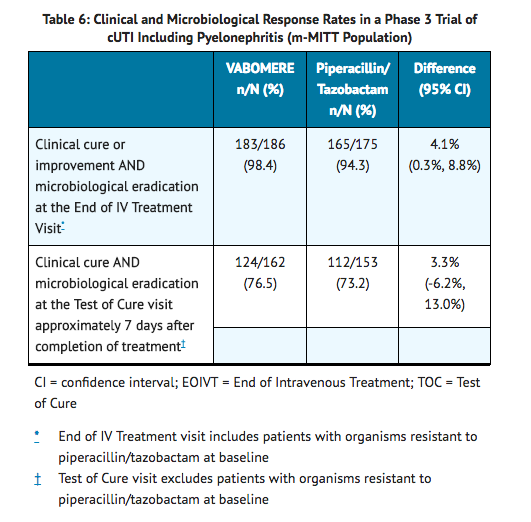
- In the m-MITT population, the rate of clinical and microbiological response in meropenem/vaborbactam- treated patients with concurrent bacteremia at baseline was 10/12 (83.3%).
- In a subset of the E. coli and K. pneumoniae isolates, genotypic testing identified certain ESBL groups (e.g., TEM, CTX-M, SHV and OXA) in both treatment groups of the Phase 3 cUTI trial. The rates of clinical and microbiological response were similar in the ESBL-positive and ESBL-negative subset at EOIVT; at TOC, clinical and microbiological response was lower in the ESBL-positive as compared to ESBL-negative subset in both treatment groups.
How Supplied
- Meropenem/vaborbactam 2 grams (meropenem and vaborbactam) for injection is supplied as a white to light yellow sterile powder for constitution in single-dose, clear glass vials (NDC 70842-120-01) sealed with a rubber stopper (not made with natural rubber latex) and an aluminum overseal. Each vial is supplied in cartons of 6 vials (NDC 70842-120-06).
- Each vial contains 1 gram of meropenem (equivalent to 1.14 grams of meropenem trihydrate), 1 gram of vaborbactam, and 0.575 gram of sodium carbonate.
Storage
- Store meropenem/vaborbactam vials at 20°C to 25°C (68°F to 77°F); excursions are permitted to 15°C to 30°C (59°F to 86°F).
Images
Drug Images
{{#ask: Page Name::Meropenem / vaborbactam (Vabomere) |?Pill Name |?Drug Name |?Pill Ingred |?Pill Imprint |?Pill Dosage |?Pill Color |?Pill Shape |?Pill Size (mm) |?Pill Scoring |?NDC |?Drug Author |format=template |template=DrugPageImages |mainlabel=- |sort=Pill Name }}
Package and Label Display Panel
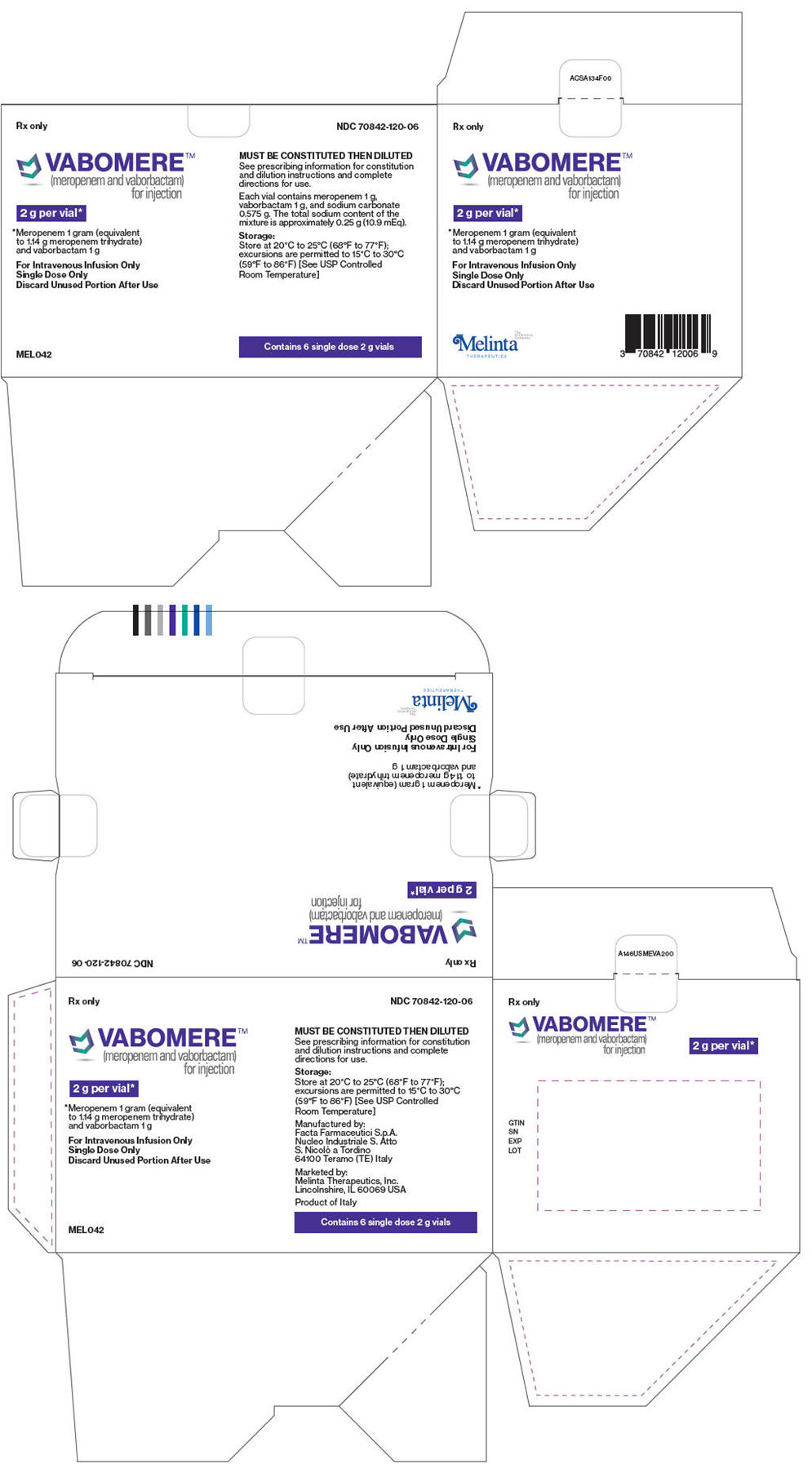
{{#ask: Label Page::Meropenem / vaborbactam (Vabomere) |?Label Name |format=template |template=DrugLabelImages |mainlabel=- |sort=Label Page }}
Patient Counseling Information
Serious Allergic Reactions
- Advise patients that allergic reactions, including serious allergic reactions, could occur and that serious reactions require immediate treatment. Ask patient about any previous hypersensitivity reactions to meropenem/vaborbactam, penicillins, cephalosporins, other beta-lactams, or other allergens.
Seizures
- Patients receiving meropenem/vaborbactam on an outpatient basis must be alerted of adverse events such as seizures, delirium, headaches and/or paresthesias that could interfere with mental alertness and/or cause motor impairment. Until it is reasonably well established that meropenem/vaborbactam is well tolerated, patients should not operate machinery or motorized vehicles.
Potentially Serious Diarrhea
- Counsel patients that diarrhea is a common problem caused by antibacterial drugs including meropenem/vaborbactam, which usually ends when the antibacterial drug is discontinued. Sometimes after starting treatment with antibacterial drugs, patients can develop watery and bloody stools (with or without stomach cramps and fever) even as late as two or more months after having taken the last dose of the antibacterial drug. If this occurs, patients should contact their physician as soon as possible.
Interaction with Valproic Acid
- Counsel patients to inform their physician if they are taking valproic acid or divalproex sodium. Valproic acid concentrations in the blood may drop below the therapeutic range upon co-administration with meropenem/vaborbactam. If treatment with meropenem/vaborbactam is necessary and continued, alternative or supplemental anti-convulsant medication to prevent and/or treat seizures may be needed.
Antibacterial Resistance
- Counsel patients that antibacterial drugs, including meropenem/vaborbactam, should only be used to treat bacterial infections. They do not treat viral infections (e.g., the common cold). When meropenem/vaborbactam is prescribed to treat a bacterial infection, tell patients that although it is common to feel better early in the course of therapy, take the medication exactly as directed. Skipping doses or not completing the full course of therapy may (1) decrease the effectiveness of the immediate treatment and (2) increase the likelihood that bacteria will develop resistance and will not be treatable by meropenem/vaborbactam or other antibacterial drugs in the future.
Precautions with Alcohol
Alcohol-Meropenem / vaborbactam (Vabomere) interaction has not been established. Talk to your doctor regarding the effects of taking alcohol with this medication.
Brand Names
- Vabomere
Look-Alike Drug Names
There is limited information regarding Meropenem / vaborbactam (Vabomere) Look-Alike Drug Names in the drug label.
Drug Shortage Status
Drug Shortage
Price
References
The contents of this FDA label are provided by the National Library of Medicine.
